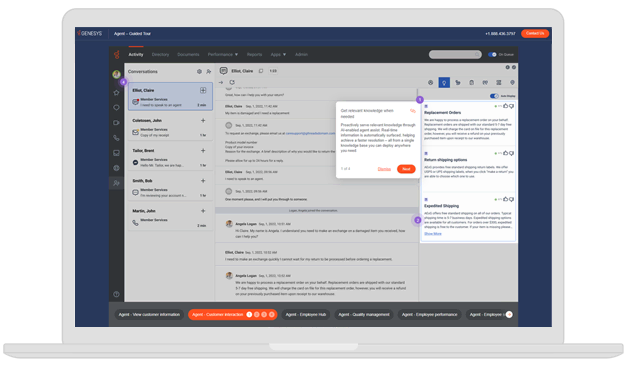
Artificial intelligence (AI) is all the rage these days, but it’s more than just buzz. Seventy percent of customer experience (CX) leaders report that AI is a business imperative, and 83% believe AI will be a clear differentiator for them in the future. Additionally, 64% of consumers surveyed in another Genesys report believe AI will improve the quality and speed of customer service over the next two to three years.
With AI is expected to become ever-present in customer experience, AI literacy is critical for contact center leaders, IT teams and CX professionals alike.
To understand AI, foundations are critical. Simply understanding the vocabulary around AI can go a long way toward making it easier to inform yourself and others. So here’s a short list of common AI terms and general definitions you should know today.
Because the world of AI is dynamic and ever-changing, we’ll update this glossary with new terms as they emerge. Feel free to bookmark it and come back for more learning as time goes on.
AI fundamentals in the contact center
AI is redefining the core functions of a contact center. Communication tools, internal and external efficiencies, and even what an agent does on a daily basis are all being reshaped as part of the AI movement. These foundational AI capabilities are at the heart of this change.
-
- Contact center artificial intelligence: This is the use of machine learning and natural language processing (NLP) to automate and optimize call center operations. Contact center AI is designed to streamline customer interactions and enhance the overall customer experience by providing personalized, efficient and effective support.
-
- Conversational AI: Conversational AI is the use of artificial intelligence to power automated communication tools, such as chatbots and virtual assistants, that can engage in natural conversations with customers. It allows businesses to offer faster and more efficient interactions across channels. Conversational AI also allows for greater self-service offerings, giving human agents the time to handle more critical, less repetitive tasks. With conversational AI for call centers, the technology is used to automate responses, handle routine inquiries and provide 24/7 support, improving efficiency and customer satisfaction.
-
- Conversational intelligence: This involves the use of AI to analyze, interpret and derive insights from customer interactions across all channels. Conversational intelligence helps contact centers understand customer intent, sentiment and behavior. These insights can be used to improve agent performance, optimize workflows, personalize experiences and proactively identify opportunities or issues.
-
- AI call center agent: AI call center agent, virtual agent and intelligent virtual agents are similar in that they handle customer service interactions independent of human intervention. It can understand and respond to customer queries, resolve issues and perform transactions on its own — with little to no human interaction. AI call center agents offer a scalable and cost-effective way to handle large volumes of requests without having to hire and train additional human agents.
-
- Virtual agent: Virtual agents use AI to create a customer service agent via chatbot functionality. These virtual agents can handle customer queries without human intervention, or if necessary can smoothly escalate an issue to a person.
-
- Intelligent virtual agents (IVAs): These AI-powered agents are capable of managing two-way text conversations in addition to voice interactions. IVAs can perform tasks such as setting sales appointments, scheduling callbacks and handling customer service inquiries.
-
- AI-powered customer engagement platforms: These customer engagement platforms use AI to automate and enhance customer interactions across voice and digital channels. They enable organizations to compose their ideal solution from a vast array of native components, a broad partner ecosystem and open APIs.
-
- AI summarization: AI summarization in contact centers involves the use of generative artificial intelligence to automatically summarize customer interactions, such as calls, chats and emails. This helps supervisors in quickly understanding the essence of customer queries or feedback without a person having to go through the entire interaction, enabling faster response times and more personalized service.
Core technologies driving AI innovation
What goes into AI — what are the components that make the technology work? Let’s examine a few of these core elements and how they work so you can make more informed decisions about AI.
-
- Large language models (LLM): This type of artificial intelligence is trained on vast amounts of text data, enabling the technology to understand and generate human language. In a contact center context, LLMs power advanced capabilities like summarizing conversations, predicting customer intent and enabling natural-sounding virtual agents. These models learn from patterns in language and context, making them more effective as time goes on.
-
- Natural language processing (NLP): This is a branch of artificial intelligence that enables computers to understand, interpret and generate human language. It involves breaking down language into smaller pieces, analyzing grammar and semantics, and understanding context.
-
- Natural language understanding (NLU): This is a sub-branch of NLP that’s focused specifically on interpreting meaning, intent and context in human language — going beyond keyword detection and truly understanding it. In contact centers, NLU is key to accurately handling complex questions, improving virtual agent performance and ensuring customers get the right response more quickly.
AI to power personalization and customer journeys
Today’s customer expects a more personalized experience than ever before, and AI can be one of the most important tools to help make that happen at scale. Here are some ways that AI is helping customer experience experts to deliver more human-centered and personalized interactions.
-
- AI experience orchestration: Leveraging AI to coordinate and manage customer experiences across touchpoints and channels. AI compiles and analyzes customer data, finding patterns and making recommendations on the next best action for a customer based on their needs and prior actions.
-
- AI-driven customer journey orchestration: This is the application of AI technology to dynamically manage and optimize the customer journey. AI gathers data from each customer touchpoint to discover where the customer has been and uses that knowledge to determine their needs and intent, and where they need to go next — working at scale, allowing for a fully personalized experience for every customer.
-
- AI-driven personalized marketing: The use of AI to tailor experiences to individual customers. Not only can AI understand and predict a specific customer’s intent, but it can also help them reach a service resolution faster. If an interaction requires human support, AI recognizes it and passes all the conversational history and context to the agent when escalating the interaction to ensure that their individual needs are met without having to repeat information.
-
- AI-driven real-time offers: Using AI, these are personalized offers and recommendations delivered to customers at the right moment, allowing companies to analyze customer behavior and context in real time to identify opportunities. These precisely timed content offers can help to improve service and drive sales conversions by personalizing the experience and only offering products or services that the particular customer may have interest in.
-
- Customer segmentation and AI: This uses AI to match a prospect or customer to the appropriate intent and priority, identifying the likely interests, shopping preferences and buying behaviors of a customer based on similar previous customers. Customer segmentation enables organizations to personalize experiences at scale by determining when and where to engage customers with an automated content offer, bot or agent-assisted service.
-
- AI-enabled customer insights: An example of these insights is AI-powered predictive engagement, which identifies customers’ behavior patterns to predict the segments they fit into and what they might be looking for so the next best action can be delivered. Among other things, those predictions can drive automated offers and more personalized conversations that increase satisfaction and strengthen loyalty.
-
- AI-powered customer insights: AI-powered customer insights leverage artificial intelligence and machine learning to analyze vast amounts of customer data more quickly and efficiently than a person can. These insights allow you to predict customer behaviors, personalize individual interactions and optimize customer journeys based on data-driven recommendations.
AI for agents, admins and supervisors
AI can do more than just analyze data and provide insights. It’s a true partner for customer service agents, administrators and supervisors alike. It can act as an assistant, or copilot, to provide assistance in real time — surfacing knowledge at the moment it’s needed, augmenting agent workloads to help get more done and automating rote tasks so humans don’t have to spend time on them.
-
- Copilot: In the context of AI and contact center software, a copilot is an AI assistant that supports various roles (agents, supervisors and admins) by providing real-time assistance, insights and automation capabilities. It can enhance decision-making, productivity and customer experiences through intelligent recommendations and by automating certain tasks.
-
- Admin copilot: An admin copilot can provide contact center administrators with AI-powered tools to streamline operations. This includes automating scheduling, workforce management, analytics and reporting tasks. By leveraging AI, admin copilot can help to optimize resource allocation, predict call volumes and enhance overall operational efficiency throughout the contact center.
-
- Supervisor copilot: A supervisor copilot aids supervisors in monitoring and managing the performance of agents in a contact center. It offers insights into things like call quality, agent productivity and customer satisfaction metrics. By analyzing every interaction, supervisor copilot can identify coaching opportunities and recommend interventions to improve team performance and ensure service standards are being met.
Agentic AI and autonomous systems
AI can even go beyond supporting agents, supervisors and admins to act independently without the help of a human. This “agentic AI” is able to make its own decisions and interact directly with customers, meaning all kinds of contact center employees can focus on the more complex and subtle tasks that require a human touch like creativity or emotion.
-
- Agentic AI: This is an AI system that can make decisions on its own and take frequent actions without human intervention. It can learn from each interaction, continuously optimize outcomes and adjust its strategies by interpreting real-time data and context — therefore developing and improving over time without reprogramming. Real agentic AI operates with freedom, solves dynamic, non-deterministic problems and executes without relying on rigid, predefined paths. The ability to operate independently in this way can enhance responsiveness, reduce human error and improve customer experiences by delivering the right actions at the right times.
-
- Agentic system: An agentic system is any software framework that shows “agency” by perceiving its environment, processing information and taking actions to meet its predefined goals. They blend automation, data insights and event-driven logic to proactively make decisions and solve problems without continuous human oversight. In a customer experience context, an agentic system can streamline workflows, improve outcomes and free human agents to focus on more complex tasks or those that require a human touch.
AI for intelligence and optimization
There’s more to AI than automating tasks and real-time support. AI can also help to improve your contact center’s strategy, the quality of interactions and overall operational excellence by analyzing large amounts of data faster and more efficiently than would be possible for a human.
-
- AI-driven analytics: This is the use of AI to gather and analyze large datasets, uncovering patterns and insights that a human might miss that can be used to inform business tactics and strategy. In this way, AI can be helpful in improving the customer experience, as it can surface the full range of customer data to see where an individual has been, what they’ve done, and then determine what they’re likely to do next.
-
- Customer feedback analysis with AI: Contact centers leverage AI to analyze customer feedback across a variety of channels such as product reviews, social media and emails. This includes things like sentiment analysis, which can assess whether feedback is positive or negative. This AI-powered analysis enables an organization to extract valuable insights that it can use to improve its products, services and customer experiences over time.
-
- Speech analytics: Speech analytics uses AI-powered natural language understanding (NLU) to analyze voice recordings or live customer calls. This analysis can spot topics or key phrases; identify customer intent and sentiment as it shifts within an interaction; and help contact centers assess agent performance.
-
- Sentiment analysis: The process of analyzing speech or text to identify the emotional tone. This can also be referred to as opinion mining. The process uses AI-powered NLP to determine how the customer feels throughout an interaction. This information is an important component of Voice of the Customer (VoC) analysis.
Responsible AI
As businesses leverage AI to empower their employees and improve efficiency, it’s important to keep in mind that AI is not a perfect tool. Like anything else — including people — AI can make mistakes. Companies must act responsibly and ethically when using AI, to help prevent mistakes.
-
- Bias: In the context of AI, this refers to systematic errors in how AI models interpret data or make decisions, often reflecting imbalances in the data they were trained on. In a contact center, bias can lead to unfair or inconsistent treatment of certain customer groups — such as misinterpreting intent, offering different levels of service or reinforcing stereotypes. Mitigating bias is essential to building ethical, inclusive AI systems that deliver fair and trustworthy customer experiences.
-
- Ethical AI: This is the practice of designing, developing and deploying AI systems in a manner that is morally responsible and aligns with a business’ values. Ethical AI should follow strict guidelines that safeguard businesses by applying AI with a purpose, adhering to data standards and addressing bias. Privacy design principles that protect customer and employee data along with intellectual property are critical. Explainability and transparency should offer insight into how algorithms are applied, enabling comprehension of operational impacts while maintaining control over the outcomes.
-
- Hallucinations: Hallucinations occur when an AI system, especially one based on large language models, generates responses that sound plausible but are factually incorrect or misleading. In a contact center setting, hallucinations could result in inaccurate answers to customer questions or flawed conversation summaries. Detecting and managing hallucinations is critical to ensuring reliability, maintaining customer trust and supporting agent decision-making.
Keeping the pulse of an AI-powered future
As AI becomes more critical to contact center operations — becoming embedded in every aspect of the customer experience — it’s more important that CX leaders build knowledge foundations and better understand the impact of AI. These definitions can help to build those foundations, but there’s always going to be more to learn.
Having a technology partner that deeply understands AI and offers tools that allow you to experience the full power of AI is critical. Realize the value of AI with the Genesys CloudTM platform, a leading AI-Powered Experience Orchestration engine that powers more connected, meaningful experiences for every customer, in every interaction, every time.
*These terms are common or emerging terms in the customer experience and contact center industries. They are not meant to be specific to Genesys or Genesys products.





